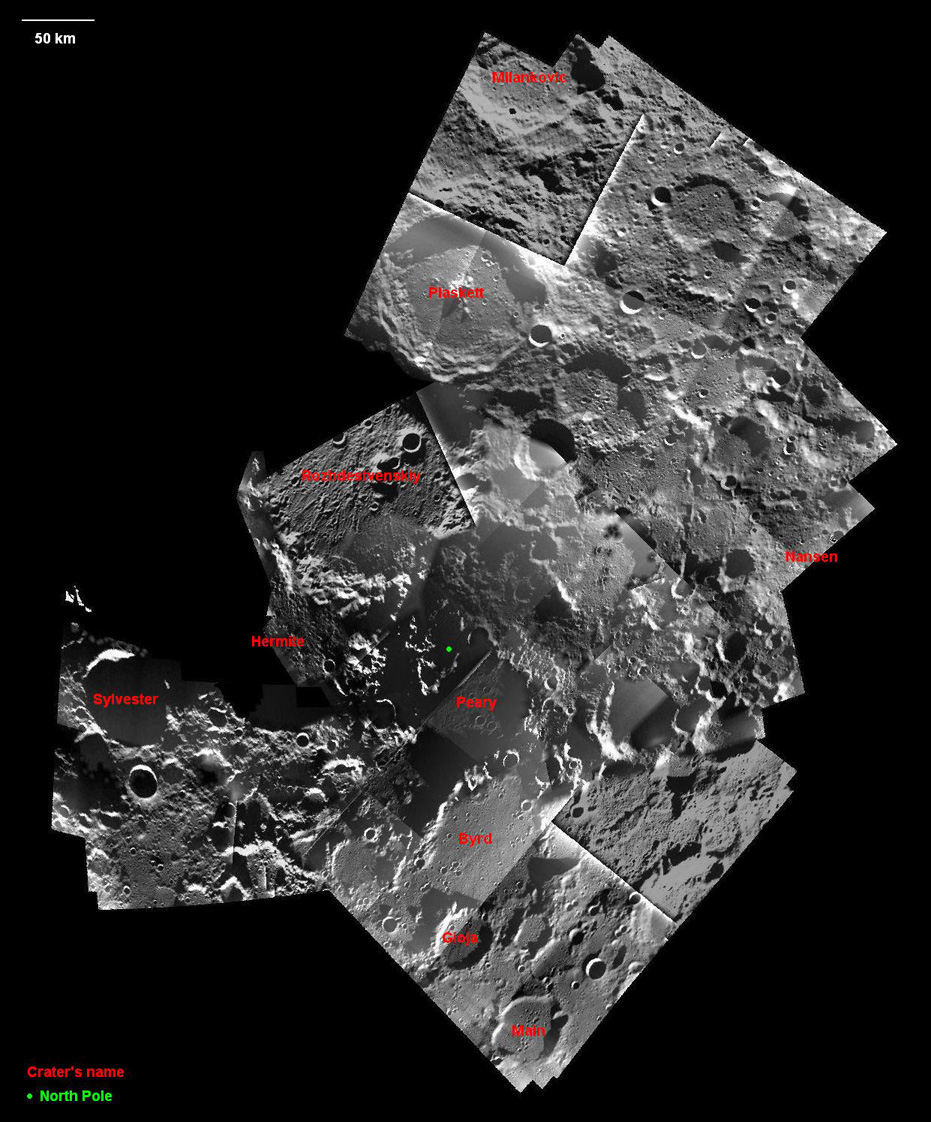|
|
| (7 intermediate revisions by 2 users not shown) |
| Line 1: |
Line 1: |
| | __NOTOC__ | | __NOTOC__ |
| | =The Whole Pole= | | =The Whole Pole= |
| | + | <!-- Start of content --> |
| | <div class="post" id="post-1573"> | | <div class="post" id="post-1573"> |
| | | | |
| Line 6: |
Line 7: |
| | <p>[[File:Mosaic_north_SMART-1-with_craters_names_H.jpg|mosaic_north_SMART-1-with_craters_names_H.jpg]]<br /> | | <p>[[File:Mosaic_north_SMART-1-with_craters_names_H.jpg|mosaic_north_SMART-1-with_craters_names_H.jpg]]<br /> |
| | <em>SMART-1 mosaic compiled by Marina Ellouzi of the Paris-Meudon Observatory. Image from [http://www.esa.int/SPECIALS/SMART-1/SEMMH029R9F_0.html ESA]</em></p> | | <em>SMART-1 mosaic compiled by Marina Ellouzi of the Paris-Meudon Observatory. Image from [http://www.esa.int/SPECIALS/SMART-1/SEMMH029R9F_0.html ESA]</em></p> |
| − | <p>The lunar north pole is the least glamorous one, lacking the deep craters and massive mountain blocks (the South Pole-Aitken Basin rim) that make the opposite pole so rugged. The reason for the lack of dramatic topography is the presence of another large basin. When the Imbrium Basin formed it dumped vast amounts of ejecta in every direction, including to the north. Much of Imbrium’s ejecta has been covered by nearside maria but it is exposed filling many of the craters between Mare Frigoris and the pole. In her nearly 30 year old north polar geology [http://astrogeology.usgs.gov/Projects/PlanetaryMapping/DIGGEOL/moon/1062/lnorth.htm map], my friend [http://astrogeology.usgs.gov/About/People/BaerbelLucchitta/ Baerbel Lucchitta] mapped Imbrium ejecta as far north as Byrd, Peary and Hermite. And ejecta from the slightly older Humboldtianum Basin reached at least as far as Nansen. So except for the younger crater of Plaskett, nearly everything here has been sanded and shallowed by basin debris. This working mosaic (put together by a lucky graduate student!), compiled from SMART-1 images taken at different times (note the changes in show directions), shows how unspectacular the area is. Lacking volcanism there are no interesting small features such as domes, sinuous rilles, or dark halo craters. But there may be a morphologically boring prize near the green dot of the pole. Water ice, captured from comet impacts, may line some of those ever-dark craters, and some of their rims may be places to capture solar energy nearly every day of the month. What more could you want for a vacation get-away?</p> | + | <p>The lunar north pole is the least glamorous one, lacking the deep craters and massive mountain blocks (the South Pole-Aitken Basin rim) that make the opposite pole so rugged. The reason for the lack of dramatic topography is the presence of another large basin. When the Imbrium Basin formed it dumped vast amounts of ejecta in every direction, including to the north. Much of Imbrium’s ejecta has been covered by nearside maria but it is exposed filling many of the craters between Mare Frigoris and the pole. In her nearly 30 year old north polar geology [https://pubs.usgs.gov/imap/1062/plate-1.pdf map], my friend [https://astrogeology.usgs.gov/people/baerbel-lucchitta Baerbel Lucchitta] mapped Imbrium ejecta as far north as Byrd, Peary and Hermite. And ejecta from the slightly older Humboldtianum Basin reached at least as far as Nansen. So except for the younger crater of Plaskett, nearly everything here has been sanded and shallowed by basin debris. This working mosaic (put together by a lucky graduate student!), compiled from SMART-1 images taken at different times (note the changes in show directions), shows how unspectacular the area is. Lacking volcanism there are no interesting small features such as domes, sinuous rilles, or dark halo craters. But there may be a morphologically boring prize near the green dot of the pole. Water ice, captured from comet impacts, may line some of those ever-dark craters, and some of their rims may be places to capture solar energy nearly every day of the month. What more could you want for a vacation get-away?</p> |
| | <p>[mailto:tychocrater@yahoo.com Chuck Wood]</p> | | <p>[mailto:tychocrater@yahoo.com Chuck Wood]</p> |
| | <p><strong>Technical Details:</strong><br /> | | <p><strong>Technical Details:</strong><br /> |
| − | [[mosaic_north-SMART-1_H.jpg|Here]] is a large image without the names -click to enlarge.</p> | + | [http://www.esa.int/images/mosaic_north-SMART-1_H.jpg Here] is a large image without the names -click to enlarge.</p> |
| | <p><strong>Related Links:</strong><br /> | | <p><strong>Related Links:</strong><br /> |
| | Rükl charts I & II<br /> | | Rükl charts I & II<br /> |
| − | [http://www.lpod.org/?m=20060224 An Earth view]</p> | + | [[February_24,_2006|An Earth view]]</p> |
| − | <p align="center"><em>Get ready for Christmas giving and support LPOD when you buy ANYTHING from Amazon thru [http://www.lpod.org/?page_id=591 LPOD!]</em></p> | + | <p><b>Yesterday's LPOD:</b> [[December 7, 2007|Which Way is Downslope?]] </p> |
| | + | <p><b>Tomorrow's LPOD:</b> [[December 9, 2007|Mystery Moon]] </p> |
| | + | <!-- Removed reference to store page 2 --> |
| | </div> | | </div> |
| − | ---- | + | <!-- End of content --> |
| − | ===COMMENTS?===
| + | {{wiki/ArticleFooter}} |
| − | Click on this icon [[image:PostIcon.jpg]] at the upper right to post a comment.
| |




